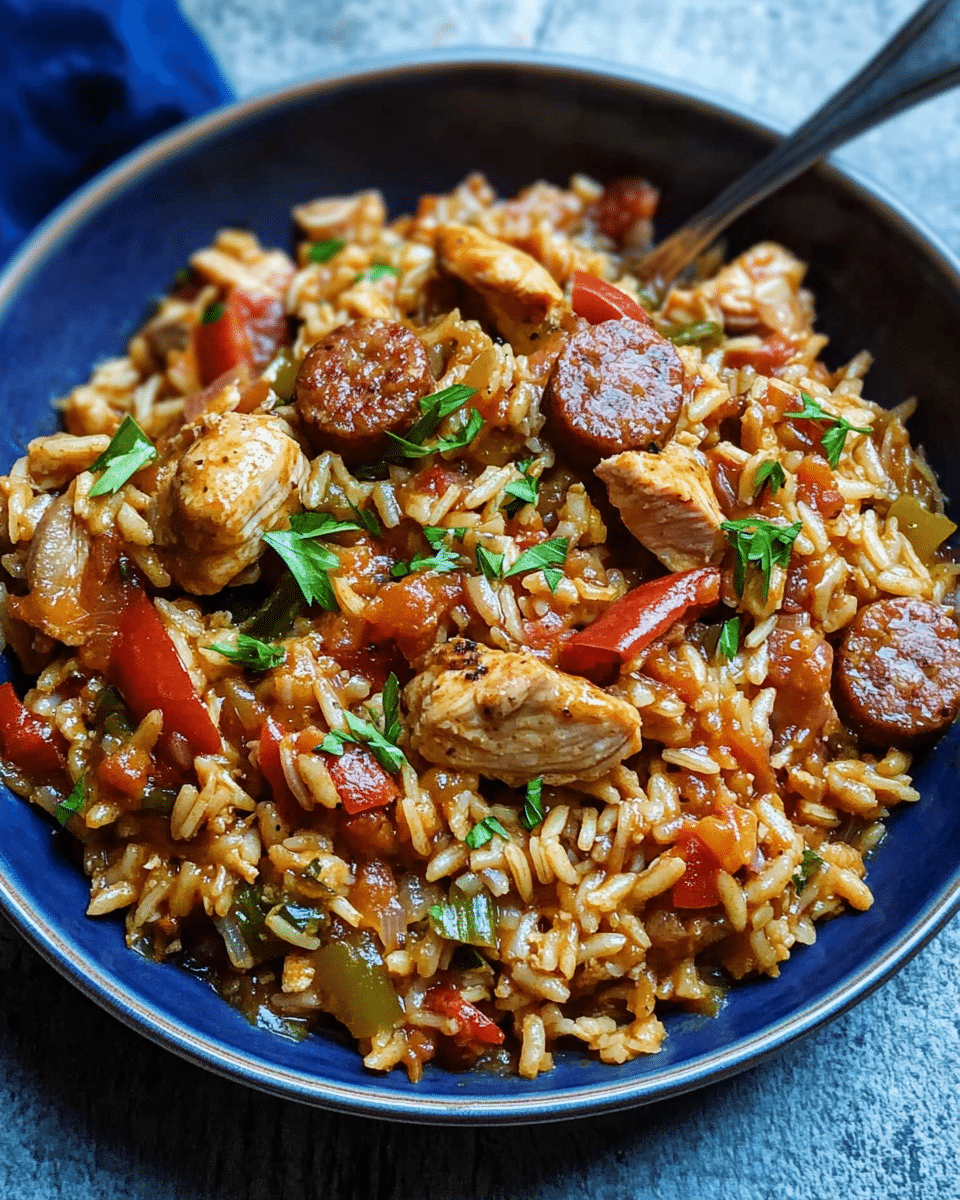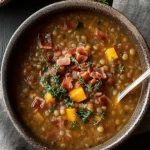This One-Pot Chicken and Sausage Jambalaya is the ultimate comfort food that delivers a bold and smoky punch in every bite. With tender chicken, hearty sausage, and perfectly seasoned rice, it captures the true essence of Louisiana cooking in a simple and approachable way. The layers of flavor come together beautifully in a single pot, making it both convenient and deeply satisfying.
Whether you’re cooking for your family on a weeknight or entertaining guests for a casual gathering, this jambalaya brings warmth and southern charm to the table. Garnished with fresh parsley and green onions, each serving is not only flavorful but also visually inviting. It’s the kind of meal that feels festive, nourishing, and memorable all at once.
Full Recipe:
Ingredients:
-
2 tablespoons olive oil
-
1 pound chicken thighs, boneless and skinless, cut into bite-sized pieces
-
12 ounces smoked sausage (such as andouille), sliced
-
1 medium onion, chopped
-
1 green bell pepper, chopped
-
1 celery stalk, chopped
-
3 garlic cloves, minced
-
1 ½ cups long-grain white rice
-
1 can (14.5 ounces) diced tomatoes, undrained
-
3 cups chicken broth
-
2 teaspoons Cajun seasoning
-
1 teaspoon paprika
-
½ teaspoon dried thyme
-
1 bay leaf
-
½ teaspoon salt (or to taste)
-
¼ teaspoon black pepper
-
2 green onions, sliced, for garnish
-
Fresh parsley, chopped, for garnish
Directions:
-
Heat olive oil in a large heavy-bottomed pot over medium heat.
-
Add chicken and cook until lightly browned on all sides, about 5 minutes. Remove and set aside.
-
Add sliced sausage to the pot and cook until browned, about 4 minutes. Remove and set aside with the chicken.
-
In the same pot, add onion, bell pepper, and celery. Sauté until softened, about 5 minutes. Stir in garlic and cook for 1 more minute.
-
Add rice and stir to coat with the vegetables and oil, toasting lightly for 1-2 minutes.
-
Stir in diced tomatoes (with juice), chicken broth, Cajun seasoning, paprika, thyme, bay leaf, salt, and pepper.
-
Return chicken and sausage to the pot, mixing well.
-
Bring to a boil, then reduce heat to low. Cover and simmer for 25–30 minutes, until rice is cooked and liquid is absorbed.
-
Remove bay leaf, fluff rice, and garnish with green onions and parsley before serving.
Prep Time: 15 minutes | Cooking Time: 40 minutes | Total Time: 55 minutes
Kcal: 480 kcal | Servings: 6 servings
One-Pot Chicken and Sausage Jambalaya
When it comes to soul-warming meals that carry history, culture, and bold flavors in every bite, Jambalaya stands out as one of the most beloved dishes of Louisiana cuisine. This hearty one-pot wonder, brimming with tender chicken, smoky sausage, aromatic vegetables, and perfectly seasoned rice, is more than just dinner; it’s a celebration of Cajun and Creole culinary traditions. Known for being both comforting and festive, Jambalaya has become a classic across kitchens worldwide, making it a perfect addition to your cooking repertoire.
In this article, we’ll explore the roots of Jambalaya, its cultural significance, what makes this Chicken and Sausage Jambalaya so special, and provide useful tips and variations so you can make it your own. By the end, you’ll not only have a delicious recipe to prepare but also a deeper appreciation for this Southern gem.
A Brief History of Jambalaya
The origins of Jambalaya are as flavorful as the dish itself. This iconic rice-based meal was born in Louisiana, a state rich in cultural diversity, where French, Spanish, African, and Caribbean influences blended into what we now know as Creole and Cajun cuisines.
The word “Jambalaya” is believed to come from the Provençal word “jambalaia,” meaning a mix or mishmash, which fits perfectly given the medley of ingredients found in the dish. In Spanish culture, paella played a significant role in inspiring Jambalaya. When Spaniards settled in Louisiana, they tried to recreate paella but often lacked saffron, one of its key components. To adapt, they used available local ingredients, adding smoked sausages, chicken, spices, and the “holy trinity” of Cajun cooking: onion, bell pepper, and celery.
Over time, the dish took on two distinct styles: Creole Jambalaya (red jambalaya), which uses tomatoes, and Cajun Jambalaya (brown jambalaya), which does not. Both are beloved, and both represent the culinary soul of Louisiana.
Why This Jambalaya Works
This particular Chicken and Sausage Jambalaya is a beautiful balance of bold Cajun seasoning, smoky sausage, and tender chicken, all simmered with fluffy rice that absorbs every ounce of flavor. The dish works so well because:
-
It’s a one-pot meal – Everything cooks in the same pot, making it convenient with minimal cleanup.
-
It’s deeply flavorful – By browning the chicken and sausage first, you build a flavor foundation before layering in vegetables, rice, and broth.
-
It’s customizable – While this version uses chicken thighs and smoked sausage, you can swap in shrimp, turkey sausage, or even make it vegetarian with beans and vegetables.
-
It’s filling and budget-friendly – Using simple pantry staples like rice, canned tomatoes, and broth, you can feed a crowd without breaking the bank.
-
It celebrates tradition – With roots tied to Louisiana’s rich culture, this dish brings a taste of New Orleans right to your dinner table.
The Heart of the Dish: Key Ingredients
To understand why Jambalaya is so delicious, let’s break down its essential components:
-
Chicken: Tender pieces of chicken thighs provide richness and protein. Dark meat is often preferred for its juiciness, but chicken breast can also be used.
-
Sausage: Traditionally, andouille sausage is used, offering smoky depth and spice. If you can’t find andouille, smoked sausage works beautifully.
-
The Holy Trinity: Onions, celery, and bell pepper are the backbone of Cajun and Creole cooking, much like mirepoix in French cuisine. They create an aromatic base that infuses the dish with flavor.
-
Rice: Long-grain white rice is best, as it cooks up fluffy and absorbs the flavors without clumping.
-
Seasonings: Cajun seasoning, paprika, thyme, and bay leaf bring warmth and complexity. Adjust the spice level to suit your taste.
-
Tomatoes: Used in this version for a Creole-style Jambalaya, they add a subtle sweetness and tang.
-
Broth: Chicken broth ties it all together, enriching the rice with a savory depth.
Cooking Technique That Makes It Special
The magic of Jambalaya lies in its cooking method. By sautéing the meat and vegetables first, you build a robust foundation. Toasting the rice in the aromatics before adding the liquid enhances the nutty notes and ensures the grains cook evenly. Finally, simmering everything together lets the flavors marry beautifully, producing a dish where every spoonful delivers balance: smoky, savory, slightly spicy, and deeply comforting.
Variations to Try
Jambalaya is incredibly versatile. Here are some delicious ways to adapt the recipe:
-
Seafood Jambalaya: Add shrimp, crawfish, or crab toward the end of cooking for a coastal twist.
-
Vegetarian Jambalaya: Replace chicken and sausage with hearty vegetables like mushrooms, zucchini, and beans. Smoked paprika can mimic some of the depth from sausage.
-
Spicy Jambalaya: Turn up the heat with extra Cajun seasoning, cayenne pepper, or hot sauce.
-
Brown Jambalaya: Skip the tomatoes to make a Cajun-style version that highlights smoky flavors.
-
Holiday Jambalaya: Add turkey sausage, leftover roasted turkey, or ham for a festive twist.
Perfect Pairings
While Jambalaya is a meal on its own, pairing it with a few sides can make it even more special:
-
Cornbread: Slightly sweet cornbread balances the spice.
-
Collard Greens or Kale: Adds freshness and earthy depth.
-
Green Salad: Light and crisp, it cuts through the richness of the dish.
-
Fried Okra: Another southern classic that adds crunch.
-
Sweet Tea or Lemonade: Refreshing drinks that pair perfectly with Cajun spices.
Tips for Success
-
Use a heavy-bottomed pot or Dutch oven – It distributes heat evenly, preventing the rice from burning.
-
Don’t rush the browning – The caramelized bits from the chicken and sausage are essential for flavor.
-
Adjust spice to taste – Cajun seasoning blends can vary, so start moderate and add more if desired.
-
Let it rest – After cooking, let the Jambalaya sit covered for 5–10 minutes. This helps the rice finish steaming and stay fluffy.
-
Garnish before serving – Fresh parsley and green onions add brightness and color to the final dish.
Storing and Reheating
This dish stores well, making it perfect for meal prep. Keep leftovers in an airtight container in the refrigerator for up to 4 days. Reheat gently on the stovetop with a splash of broth or water to revive the rice without drying it out. Jambalaya can also be frozen for up to 2 months, just thaw overnight in the fridge before reheating.
Why You’ll Love Serving Jambalaya
Jambalaya is more than just food; it’s an experience. From its vibrant colors to its bold flavors, this dish is festive enough for gatherings yet simple enough for weeknight dinners. It has the rare quality of being rustic and homey while still feeling special and celebratory. Sharing Jambalaya with friends and family connects you to Louisiana’s culinary traditions and brings joy to the dinner table.
Conclusion
This One-Pot Chicken and Sausage Jambalaya is a recipe that embodies comfort, culture, and convenience all in one. With its roots in Louisiana’s vibrant history, it brings together diverse flavors in a way that feels both timeless and approachable. The combination of smoky sausage, tender chicken, fluffy rice, and bold spices makes it satisfying for any occasion.
Whether you’re preparing it for a quiet family dinner, a festive party, or meal prep for the week, Jambalaya delivers on flavor and heartiness every time. Once you master this dish, it’s sure to become a favorite in your recipe collection; a dish you’ll come back to again and again whenever you crave the warm, soulful taste of Louisiana.






